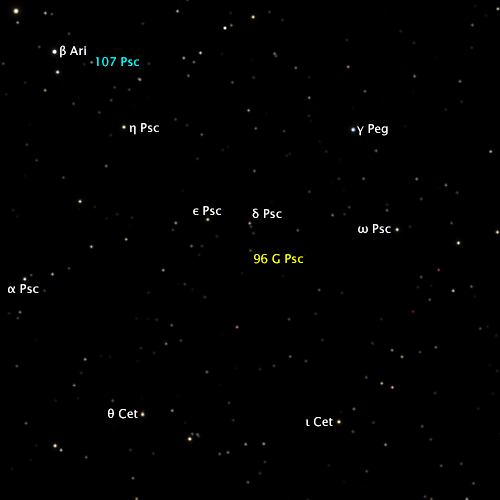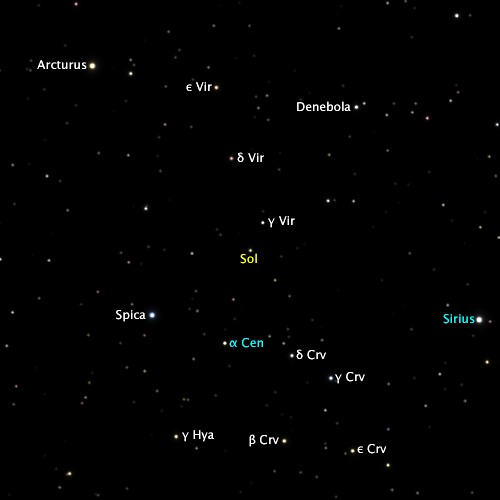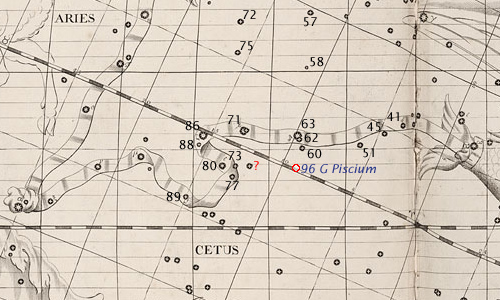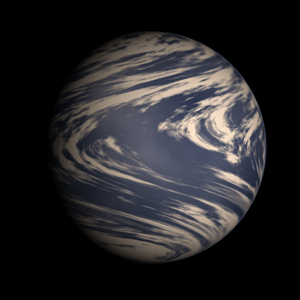as seen from Sol.
96 Piscium.


| Right Ascension | 00h 48m |
|---|---|
| Declination | +05° 17' |
| Distance | 24.27 ± 0.14 ly |
| Spectral Class | K2V |
| Estimated Mass | 0.83 × Sol |
| Luminosity | 0.23 × Sol |
| 96 Piscium as seen from Sol. |
Sol as seen from 96 Piscium. |
|---|---|
 |
 |
| Star | Magnitude | Distance |
|---|---|---|
| Canopus | −0.61 | 310.3 |
| Alpha Aurigae (Capella) | 0.01 | 41.5 |
| Rigel | 0.16 | 854.0 |
| Achernar | 0.31 | 130.4 |
| Betelgeuse | 0.43 | 492.7 |
| Fomalhaut | 0.50 | 18.5 |
| Aldebaran | 0.54 | 57.0 |
| Beta Centauri (Hadar) | 0.69 | 405.8 |
| Vega | 0.73 | 34.6 |
| Alpha Crucis (Acrux) | 0.86 | 335.5 |
| Sirius | 0.97 | 25.9 |
| Arcturus | 0.97 | 58.7 |
As seen from Earth, 96 Piscium is an unremarkable K2 dwarf star. The star has an apparent magnitude of 5.72, which makes the star just bright enough to be seen with the naked eye from dark skies. The star is listed as a double star in some star catalogues, however other research has suggested that the star has no companion.

|
This star is referred to as 96 Piscium throughout the Local Space website. Other names for this star include BD+04° 123, Gliese 33, HD 4628, HIP 3765, HR 222, LHS 121, SAO 109471 and Wolf 25. A more comprehensive list of identifiers for this star may be found on the SIMBAD database. 96 Piscium — or 96 G. Piscium, with the G being an abbreviation of Gould — is only referred to as such in a few star catalogues. Although it bears a number that looks like a Flamsteed number, that number is not a Flamsteed number and is out of sequence with the true Flamsteed numbers of nearby stars (see map). It appears to be missing from some of Flamsteed’s maps even though many stars a full magnitude fainter do appear on these maps.
A possible explanation on why the star is missing may be found by a careful inspection of the map. There is a star at the same declination as 96 Piscium and separated from its position by three degrees that does not correspond to the position of any known star of comparable brightness and position. (This star is indicated on the map with a question mark.) It is possible that 96 Piscium was not plotted in the correct position on the map. The Flamsteed maps are known to contain some errors (for example, 34 Tauri is really the planet Uranus) and this star could be one of these errors. The displacement is not due to proper motion because the proper motion of 96 Piscium is much smaller than the proper motion implied by the map and is in a different direction.
| Destination | Distance |
|---|---|
| Omicron2 Eridani A | 19.6 |
| 61 Cygni A | 21.1 |
| 107 Piscium | 8.5 |
| Kappa1 Ceti | 18.2 |
The first probe of the Dandelion Project reached this star system in August 2851.
| Planet | SMA (AU) |
Orbital Period |
e | Equatorial Diameter (km) |
Mass (Earths) |
Density (g/cm3) |
Gravity (Earth g) |
Atmospheric Pressure (Earth=1) |
Sidereal Day |
Mean Solar Day |
Axial Tilt |
Known Moons |
|---|---|---|---|---|---|---|---|---|---|---|---|---|
| Belgana | 0.2197 | 44.008 d | 0.0034 | 5779 | 0.08731 | 5.16 | 0.4251 | 0.00000200 | 44d 00h 10.8m | Synchronous | 00° 11.1' | 0 |
| Gortalsa | 0.3643 | 93.990 d | 0.0060 | 8302 | 0.2339 | 4.66 | 0.5518 | 2.49 | 93d 23h 44.9m | Synchronous | 01° 53.1' | 0 |
| Calena | 0.6178 | 207.56 d | 0.0163 | 11060 | 0.5990 | 5.06 | 0.7958 | 1.94 | 207d 13h 31.3m | Synchronous | 01° 21.0' | 0 |
| Nilaqua | 0.8578 | 339.65 d | 0.0139 | 9628 | 0.3107 | 4.00 | 0.5449 | 0.395 | 14h 57.0m | 14h 58.7m | 06° 20.7' | 0 |
| Dheslia | 1.405 | 1.9497 y | 0.0774 | 5802 | 0.07260 | 4.26 | 0.3508 | 0.0325 | 11h 29.6m | 11h 30.0m | 45° 41.1' | 1 |
| Elsa | 2665 | 0.006135 | 3.72 | 0.1405 | 0.0 | 11h 29.6m | 11h 30.0m | 45° 41.0' | ||||
| Ja'aul | 5.584 | 15.443 y | 0.0287 | 103200 | 77.17 | 0.894 | 1.177 | &mdash | 10h 15.5m | 10h 15.6m | 03° 36.2' | 15 |
| Bandora | 10.34 | 38.937 y | 0.0194 | 87180 | 61.49 | 1.12 | 1.316 | &mdash | 13h 01.1m | 13h 01.2m | 50° 14.1' | 10 |
| Amarra | 19.98 | 104.52 y | 0.0557 | 52810 | 17.46 | 1.47 | 1.018 | &mdash | 08h 54.1m | 08h 54.1m | 28° 21.3' | 11 |
| Yudonë | 190.2 | 3069.3 y | 0.4879 | 150300 | 2228 | 7.59 | 16.03 | &mdash | 09h 20.4m | 09h 20.4m | 18° 34.0' | 14 |
| Name | Diameter (km) |
Period (days) |
Semimajor Axis (km) |
Ecc | Inc |
|---|---|---|---|---|---|
| Natural Satellites of Dheslia-Elsa | |||||
| Coila | 78 | 9.693 | 82310 | 0.1050 | 6.67 |
| Natural Satellites of Ja'aul | |||||
| Ja'aul XII | 19 | 0.3966 | 97090 | 0.0008 | 0.07 |
| Ja'aul XIII | 22 | 0.4085 | 99020 | 0.0009 | 0.08 |
| Ja'aul XIV | 31 | 0.4250 | 101700 | 0.0011 | 0.55 |
| Ja'aul XV | 18 | 0.4502 | 105600 | 0.0013 | 1.03 |
| Ja'aul VII | 202 | 0.5177 | 116000 | 0.0026 | 0.25 |
| Ja'aul VI | 414 | 0.9853 | 178100 | 0.0046 | 1.37 |
| Ja'aul V | 1006 | 1.473 | 232800 | 0.0124 | 2.41 |
| Ja'aul III | 1549 | 2.449 | 326700 | 0.0117 | 1.00 |
| Ja'aul I | 4031 | 8.549 | 752000 | 0.0231 | 1.75 |
| Ja'aul II | 3952 | 17.10 | 1194000 | 0.0363 | 1.72 |
| Ja'aul IV | 1350 | 60.29 | 2765000 | 0.0991 | 5.48 |
| Ja'aul VIII | 215 | 75.99 | 3227000 | 0.0716 | 9.12 |
| Ja'aul IX | 138 | 98.68 | 3841000 | 0.0563 | 11.74 |
| Ja'aul X | 111 | 99.90 | 3872000 | 0.3997 | 12.16 |
| Ja'aul XI | 83 | 221.2 | 6578000 | 0.1077 | 21.84 |
| Natural Satellites of Bandora | |||||
| Bandora VII | 36 | 0.6096 | 119900 | 0.0006 | 0.25 |
| Bandora III | 612 | 1.072 | 174600 | 0.0013 | 0.25 |
| Bandora I | 1353 | 1.640 | 231800 | 0.0016 | 0.29 |
| Bandora II | 1513 | 2.417 | 300300 | 0.0094 | 1.42 |
| Bandora IV | 624 | 4.561 | 458600 | 0.0074 | 1.94 |
| Bandora V | 646 | 7.088 | 615300 | 0.0171 | 2.15 |
| Bandora VI | 327 | 17.73 | 1134000 | 0.0120 | 3.01 |
| Bandora VIII | 99 | 102.7 | 3656000 | 0.0280 | 3.10 |
| Bandora IX | 92 | 173.6 | 5189000 | 0.0783 | 14.08 |
| Bandora X | 38 | 225.6 | 6180000 | 0.1976 | 35.88 |
| Natural Satellites of Amarra | |||||
| Amarra VI | 31 | 0.9502 | 105900 | 0.0003 | 0.03 |
| Amarra VII | 69 | 0.9947 | 109200 | 0.0027 | 0.05 |
| Amarra II | 612 | 1.556 | 147200 | 0.0205 | 0.59 |
| Amarra I | 1480 | 3.112 | 233600 | 0.0195 | 0.94 |
| Amarra III | 1121 | 6.225 | 370800 | 0.0160 | 1.27 |
| Amarra VIII | 71 | 9.338 | 486000 | 0.1913 | 4.27 |
| Amarra IX | 53 | 21.02 | 834700 | 0.1895 | 5.60 |
| Amarra IV | 821 | 31.51 | 1093000 | 0.0241 | 1.69 |
| Amarra V | 925 | 63.03 | 1736000 | 0.0352 | 2.27 |
| Amarra X | 156 | 113.9 | 2575000 | 0.1657 | 13.21 |
| Amarra XI | 52 | 349.7 | 5440000 | 0.1879 | 5.63 |
| Natural Satellites of Yudonë | |||||
| Yudonë VIII | 62 | 0.2472 | 217400 | 0.0002 | 0.03 |
| Yudonë IX | 69 | 0.2584 | 223900 | 0.0016 | 0.16 |
| Yudonë X | 113 | 0.3053 | 250200 | 0.0003 | 0.15 |
| Yudonë VI | 262 | 0.4704 | 333700 | 0.0101 | 0.40 |
| Yudonë II | 1689 | 1.294 | 655100 | 0.0081 | 1.84 |
| Yudonë III | 1480 | 2.586 | 1040000 | 0.0178 | 2.13 |
| Yudonë I | 11470 | 9.056 | 2397000 | 0.0132 | 1.93 |
| Yudonë IV | 1033 | 40.77 | 6536000 | 0.0159 | 8.23 |
| Yudonë V | 1293 | 171.5 | 17030000 | 0.0337 | 8.73 |
| Yudonë XI | 72 | 223.6 | 20330000 | 0.0242 | 13.89 |
| Yudonë XII | 183 | 246.4 | 21680000 | 0.0883 | 1.89 |
| Yudonë XIII | 169 | 301.0 | 24780000 | 0.1386 | 22.44 |
| Yudonë VII | 586 | 547.5 | 36930000 | 0.0992 | 35.40 |
| Yudonë XIV | 129 | 2252 | 94790000 | 0.4181 | 165.12 |
Belgana is a planet that closely resembles Mercury in size, appearance and composition. Its radius is about ten per cent larger than that of Mercury. Like Mercury, it is a dense world and is believed to have a large iron-nickel core. This planet has a weak and patchy magnetic field, which is most likely a relic of an earlier strong magnetic field that is preserved in surface minerals.

|
Gortalsa is a small, hot tidelocked terrestrial planet with a dense and toxic atmosphere mostly composed of carbon dioxide. Despite the tidelocking, the planet maintains a fairly even temperature over its surface due to the dense atmosphere distributing the heat fairly efficiently over the whole planet. The planet superficially resembles Venus, however the atmosphere is much less dense and large gaps in the cloud cover allow the blue sky of the world to be seen.
The low gravity of the world and the lack of a strong magnetic field causes the world to lose its atmosphere over time to the solar wind. As the world loses its atmosphere, the remaining atmosphere conducts heat less and less efficiently, and the termperature difference between the dayside and the nightside will become more and more pronounced. Eventually the world will lose enough of its atmosphere that the remainder of the atmosphere will no longer conduct heat efficiently enough to prevent the remaining atmosphere from freezing out on the night side. When this happens, the rest of the atmosphere will be frozen out on the nightside in only a few thousand years — a mere blink of the eye on geologic timescales — and the world will become almost airless.
Calena is a habitable world that is home to a minor colony. It also has microbial life. Unlike many colony worlds, it did not require terraforming to be a suitable home for a human colony and Earth-based life.
Nilaqua is an ice-bound world with a mass of about three times that of Mars. The name means “no water” and was given that name on the belief that the world had no liquid water. This belief is false: liquid water does exist beneath the ice. However, the ice is more than thirty kilometres deep above the liquid water that lies beneath, and such water is difficult to access.
Dheslia (pronunciation: /ˈðɛs·li·ə/, alternative spelling Ðeslia) is a Mars-sized planet with a large moon, Elsa, in a close orbit. Elsa has a radius about half as large as Dheslia. Although the centre of mass of the system lies within Dheslia, Dheslia and Elsa are considered to be a double planet. The moon and planet are tidelocked to each other and have a rotation period of about 12 hours.
Yudonë (pronunciation: /juː·ˈdoː·nɛ/, /juː·ˈdəʊ·ni/ or /juː·ˈdoʊ·ni/) is a distant planet with an eccentric and somewhat inclined orbit. The planet is massive, with a mass about seven times that of Jupiter. Yudonë takes more than 3,000 years to orbit its sun once. The planet emits much more heat than it receives from its local sun. This heat comes mainly from contraction due to the Kelvin–Helmholtz mechanism. The heat causes the clouds to be quite turbulent despite the great distance from its sun.
It has a large moon nearly as large as the Earth. This moon is an inhospitable Triton-class moon with active ice volcanoes.